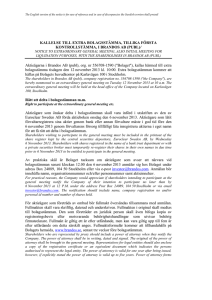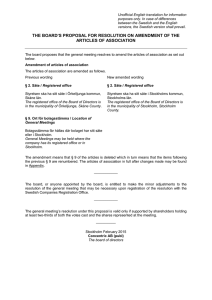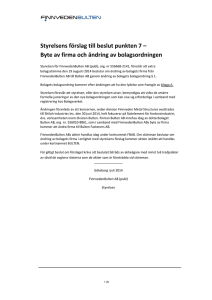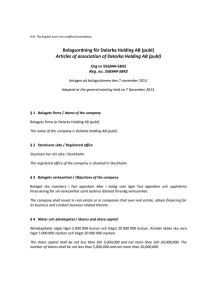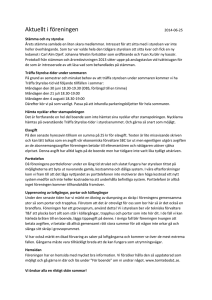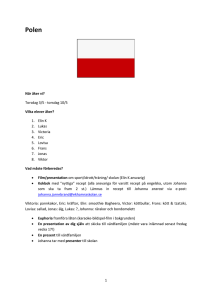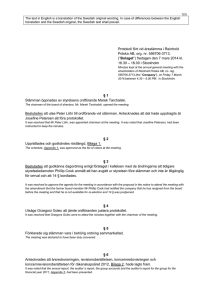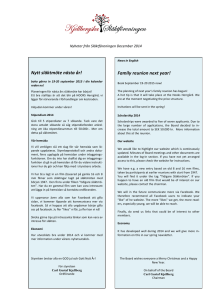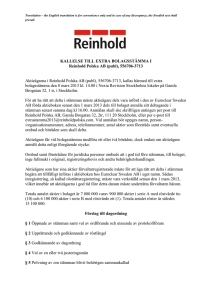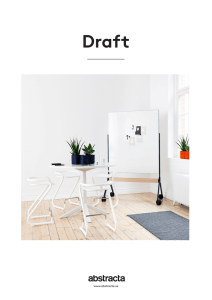ÅRSSTÄMMA REINHOLD POLSKA AB 7 MARS 2014
advertisement
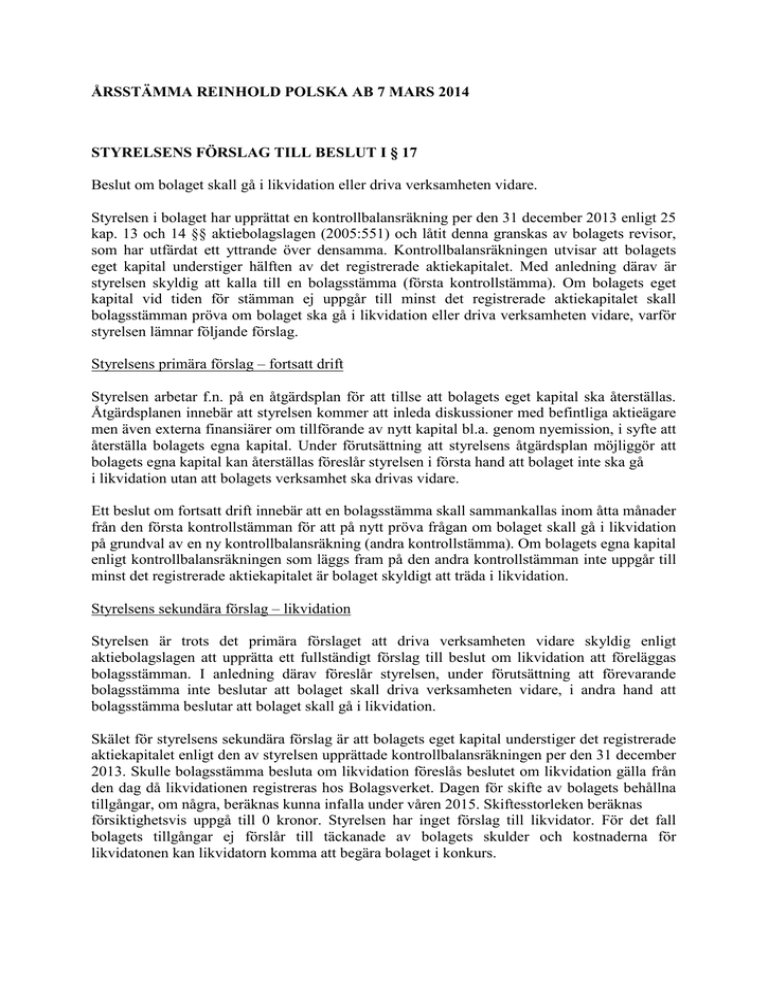
ÅRSSTÄMMA REINHOLD POLSKA AB 7 MARS 2014 STYRELSENS FÖRSLAG TILL BESLUT I § 17 Beslut om bolaget skall gå i likvidation eller driva verksamheten vidare. Styrelsen i bolaget har upprättat en kontrollbalansräkning per den 31 december 2013 enligt 25 kap. 13 och 14 §§ aktiebolagslagen (2005:551) och låtit denna granskas av bolagets revisor, som har utfärdat ett yttrande över densamma. Kontrollbalansräkningen utvisar att bolagets eget kapital understiger hälften av det registrerade aktiekapitalet. Med anledning därav är styrelsen skyldig att kalla till en bolagsstämma (första kontrollstämma). Om bolagets eget kapital vid tiden för stämman ej uppgår till minst det registrerade aktiekapitalet skall bolagsstämman pröva om bolaget ska gå i likvidation eller driva verksamheten vidare, varför styrelsen lämnar följande förslag. Styrelsens primära förslag – fortsatt drift Styrelsen arbetar f.n. på en åtgärdsplan för att tillse att bolagets eget kapital ska återställas. Åtgärdsplanen innebär att styrelsen kommer att inleda diskussioner med befintliga aktieägare men även externa finansiärer om tillförande av nytt kapital bl.a. genom nyemission, i syfte att återställa bolagets egna kapital. Under förutsättning att styrelsens åtgärdsplan möjliggör att bolagets egna kapital kan återställas föreslår styrelsen i första hand att bolaget inte ska gå i likvidation utan att bolagets verksamhet ska drivas vidare. Ett beslut om fortsatt drift innebär att en bolagsstämma skall sammankallas inom åtta månader från den första kontrollstämman för att på nytt pröva frågan om bolaget skall gå i likvidation på grundval av en ny kontrollbalansräkning (andra kontrollstämma). Om bolagets egna kapital enligt kontrollbalansräkningen som läggs fram på den andra kontrollstämman inte uppgår till minst det registrerade aktiekapitalet är bolaget skyldigt att träda i likvidation. Styrelsens sekundära förslag – likvidation Styrelsen är trots det primära förslaget att driva verksamheten vidare skyldig enligt aktiebolagslagen att upprätta ett fullständigt förslag till beslut om likvidation att föreläggas bolagsstämman. I anledning därav föreslår styrelsen, under förutsättning att förevarande bolagsstämma inte beslutar att bolaget skall driva verksamheten vidare, i andra hand att bolagsstämma beslutar att bolaget skall gå i likvidation. Skälet för styrelsens sekundära förslag är att bolagets eget kapital understiger det registrerade aktiekapitalet enligt den av styrelsen upprättade kontrollbalansräkningen per den 31 december 2013. Skulle bolagsstämma besluta om likvidation föreslås beslutet om likvidation gälla från den dag då likvidationen registreras hos Bolagsverket. Dagen för skifte av bolagets behållna tillgångar, om några, beräknas kunna infalla under våren 2015. Skiftesstorleken beräknas försiktighetsvis uppgå till 0 kronor. Styrelsen har inget förslag till likvidator. För det fall bolagets tillgångar ej förslår till täckanade av bolagets skulder och kostnaderna för likvidatonen kan likvidatorn komma att begära bolaget i konkurs. In-house translation – the English version is for convenience only and in case of any discrepancy, the Swedish text shall prevail. The decision whether the company should go into liquidation or continue operations Directors of the company have on the February 3rd 2014 prepared a control balance sheet as per December 31th 2013 in accordance with Chapter 25, art. 13 and 14 of the Swedish Companies Act (2005:551). They have let this be audited by the Company's auditor, who has issued an opinion on the same. The balance sheet shows that the company's equity is less than half of the registered share capital. For this reason the Directors are required to convene a general meeting (initial meeting). If the company's equity at the time of the meeting does not amount to a minimum of the registered share capital, the general meeting shall consider whether the company should go into liquidation or continue operations, thus leaving the Board to make the following recommendations. The Board's primary proposal - the continued operation The Board is presently working on a plan of measures to ensure that the company's equity be restored. The plan means that the board will engage in discussion with existing shareholders, but outside financiers about the addition of new capital, among other things by issuing new shares, in order to restore the company's equity. Provided that the Board's plan of measures enables the company's equity to be restored, the Board primarily proposes that the Company should continue operations and not be liquidated. A decision on continued operation means a general meeting shall be convened within eight months of the first control meeting to re-examine the question whether the company should go into liquidation on the basis of a new balance sheet (second control meeting). If the company's equity according to the balance sheet does not amount to a minimum of the registered share capital when presented on the second control meeting, the company is obliged to enter into liquidation. The Board's secondary proposals - liquidation The Board is, despite the primary proposal to continue operations, required to prepare a full proposal for a decision on liquidation to be submitted to the General Meeting under the Swedish Companies Act. In relation thereto, the Board secondarily proposes, (provided that the present General Meeting decide that the Company will not continue operations) that the Annual General Meeting authorizes the Company to go into liquidation. The reason for the board's secondary proposal is that the company's equity is less than the registered share capital in accordance with what the Board established in the control balance sheet as per 31 December 2014. Should the General Meeting decide on liquidation it is proposed that the decision be in effect from the date of the registration with the Companies House. The date of the change of the Company's remaining assets, if any, can then be expected to occur in the spring of 2105. The dividend is carefully calculated to 0. The Board has not proposed liquidator. If the company is found to lack assets to cover its remaining debts and the costs for the liquidator procedure the liquidator will file for bankruptcy.
